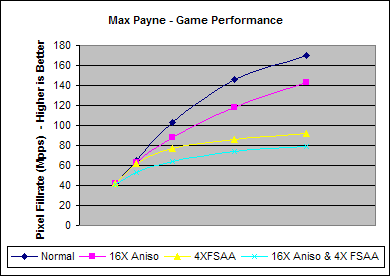Game Benchmarks
Max Payne
Max Payne is a DirectX title, which predominantly uses the DX7 feature set. Let's see how the Radeon 9700 PRO performs under this title.

| FPS | 640x480 | 800x600 | 1024x768 | 1280x1024 | 1600x1200 |
| 9700 PRO | 135.8 | 135.4 | 131.1 | 111.4 | 88.4 |
| 8500 | 127 | 106.7 | 79.2 | 53.6 | 40.5 |
| Difference | 640x480 | 800x600 | 1024x768 | 1280x1024 | 1600x1200 |
| FPS | 8.8 | 28.7 | 51.9 | 57.8 | 47.9 |
| % | 7% | 27% | 66% | 108% | 118% |
We can see from the low resolution scores that around about the 130FPS mark is the CPU limitation for this title on the P4 2.53GHz test system. Even at that resolution, though, Radeon 9700 PRO shows a small performance advantage over the Radeon 8500 - this advantage could be down to something like slightly more optimal drivers with less CPU overhead, the extra Vertex processing power of the 9700 PRO is giving it a little bit of a boost, or just that there are even a few fill rate dips on the 8500 even at this resolution and the increased fill rate of 9700 PRO helps to alleviate them slightly.
As ever, though, the telling story unfolds as you scale up the resolutions. Radeon 8500 is seeing slightly diminishing returns as soon as 800x600, topping out at 40.5 FPS at 1600x1200. On the other hand, with Radeon 9700 PRO it takes until 1280x1024 for there to be any sort of significant performance drop off, even though it's still well above 100FPS, and it tops out at 88.4FPS at 1600x1200 - in excess of double the 8500!

| 9700 PRO | 640x480 | 800x600 | 1024x768 | 1280x1024 | 1600x1200 |
| Normal | 135.8 | 135.4 | 131.1 | 111.4 | 88.4 |
| 16X Aniso | 135.4 | 131.2 | 111.9 | 90.0 | 74.7 |
| 4XFSAA | 135.3 | 128.8 | 97.8 | 65.5 | 47.8 |
| 16X Aniso & 4X FSAA | 133.0 | 109.5 | 81.9 | 56.3 | 41.0 |
| % Difference | 640x480 | 800x600 | 1024x768 | 1280x1024 | 1600x1200 |
| 16X Aniso | 0% | -3% | -15% | -19% | -15% |
| 4XFSAA | 0% | -5% | -25% | -41% | -46% |
| 16X Aniso & 4X FSAA | -2% | -19% | -38% | -49% | -54% |
Here we can see that using the highest setting 16X 'Quality' anisotropic Filtering mode we drop a maximum of 19% off the overall performance, and at 1600x1200 the frame rates are well above 60FPS - more than playable. Bear in mind that the quality mode of anisotropic filtering is able to produce trilinear sampling when told, as is the case here.
Enabling 4X FSAA takes a slightly larger hit in this title as the resolution goes up. At 1280x1024 the game is still above the 60FPS mark, which is fairly impressive, and at 1600x1200 is at about 48FPS which, dependant on you preferences, is still playable.
With both 4X FSAA and 16X 'Quality' anisotropic Filtering enabled, as we would expect the performance hit is further increased. However, the relative performance hit from going from no FSAA rendering to no FSAA with high quality filtering is greater than that of going from 4X FSAA to 4X FSAA with high quality filtering; this shows that the FSAA modes and filtering are balancing each others bottlenecks slightly, which is indicative of Multi-Sampling FSAA as it requires no extra texture samples. With both 4X FSAA and high quality filtering enabled at 1280x1024 you can see that it just sinks below the 60FPS mark and at 1600x1200 it is still slightly higher than 40FPS.
